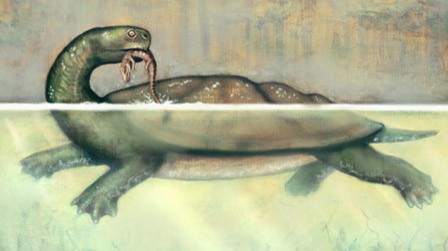Scientists Discover An Extinct Giant Turtle, The Carbonemys Cofrinii, Or 'Coal Turtle' The Size Of A Car

Researchers from the University of Florida in conjunction with scientists from North Carolina State University and the Smithsonian Tropical Research Institute, and the Florida Museum of Natural History have published their findings regarding an extinct giant turtle that is estimated to be the size of a small vehicle from a Colombian coal mine.
The Carbonemys cofrinii, or coal turtle, is estimated to be over 8 feet long from the nose to tail. This turtle reportedly represents a rapid evolution in size. A species of turtles that lived just before this giant reptile was only 2 feet long.
The turtle was originally discovered in 2005, however, it was not until 2012 that the findings were thoroughly examined and described in a scientific journal. Scientists uncovered a well-preserved skull along with the shell of the turtle. They determined that the coal turtle comes from an order of reptiles known as pleurodira, which bends its neck sideways into their shells, rather than pulling it straight back. The size of the skull is estimated to approximately about the size of a NFL football, reported Live Science.
At that size, I would imagine that it was swimming around without too much fear, said researcher Jonathan Bloch, Florida Museum associate curator of vertebrate paleontology, in a statement. The only animals it probably would've had to worry about were the dyrosaurids [ancient crocodile relatives] - we have turtle shells from the same place with bite marks on them.
Some of the researchers believe that the growth could have been triggered by evolution as a way for the turtles to fight off the giant crocodiles.
The shell of the turtle was discovered to have bite marks from ancient crocs. However, the bite marks did not appear to come even close to breaking the shell, reported Journal Now.
In tropical South America today you find many pleurodires on the banks and in the water of the rivers, so they are still a critical part of the ecosystem, said Bloch in a statement.
The turtle is believed to have walked the earth about 5 million years after dinosaurs became extinct. During this time period, gigantic reptiles flourished including the Titanoboa cerrejonensis, a 45-footlong snake.
We had recovered smaller turtle specimens from the site. But after spending about four days working on uncovering the shell, I realized that this particular turtle was the biggest anyone had found in this area for this time period - and it gave us the first evidence of gigantism in freshwater turtles, Edwin Cadena, also of North Carolina State, said in a statement.
Researchers believe that a combination of few predators, large habitat, large food supply and climate changes after the ice age, allowed these giant animals to survive.
In addition to the turtle's gigantic figure, researchers conclude that the turtle had massive, powerful jaws that would have enabled it to eat almost anything in its way.
It was so large that it may actually have been chomping on some of the smaller crocodiles itself, said Dan Ksepka, a NCSU paleontologist and a research associate at the N.C. Museum of Natural Sciences, said in a statement. Once it grew to its full size, nothing much was going to be able to eat it.
© Copyright IBTimes 2025. All rights reserved.





















